check engine light TOYOTA YARIS GRMN 2017 Owners Manual
[x] Cancel search | Manufacturer: TOYOTA, Model Year: 2017, Model line: YARIS GRMN, Model: TOYOTA YARIS GRMN 2017Pages: 404, PDF Size: 54.2 MB
Page 4 of 404
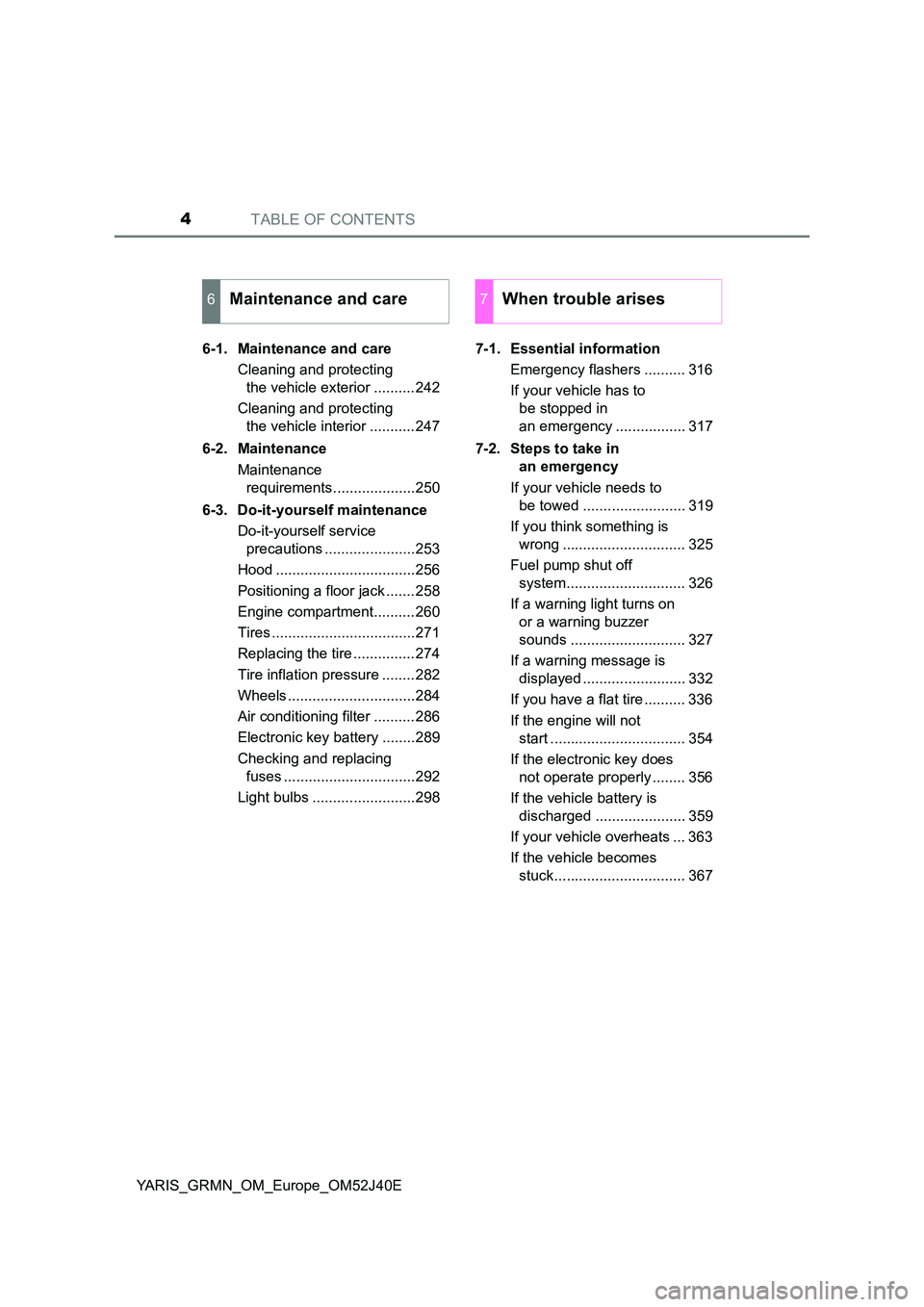
TABLE OF CONTENTS4
YARIS_GRMN_OM_Europe_OM52J40E
6-1. Maintenance and care
Cleaning and protecting
the vehicle exterior ..........242
Cleaning and protecting
the vehicle interior ...........247
6-2. Maintenance
Maintenance
requirements....................250
6-3. Do-it-yourself maintenance
Do-it-yourself service
precautions ......................253
Hood ..................................256
Positioning a floor jack .......258
Engine compartment..........260
Tires ...................................271
Replacing the tire ...............274
Tire inflation pressure ........282
Wheels ...............................284
Air conditioning filter ..........286
Electronic key battery ........289
Checking and replacing
fuses ................................292
Light bulbs .........................298
7-1. Essential information
Emergency flashers .......... 316
If your vehicle has to
be stopped in
an emergency ................. 317
7-2. Steps to take in
an emergency
If your vehicle needs to
be towed ......................... 319
If you think something is
wrong .............................. 325
Fuel pump shut off
system............................. 326
If a warning light turns on
or a warning buzzer
sounds ............................ 327
If a warning message is
displayed ......................... 332
If you have a flat tire .......... 336
If the engine will not
start ................................. 354
If the electronic key does
not operate properly ........ 356
If the vehicle battery is
discharged ...................... 359
If your vehicle overheats ... 363
If the vehicle becomes
stuck................................ 367
6Maintenance and care7When trouble arises
Page 11 of 404
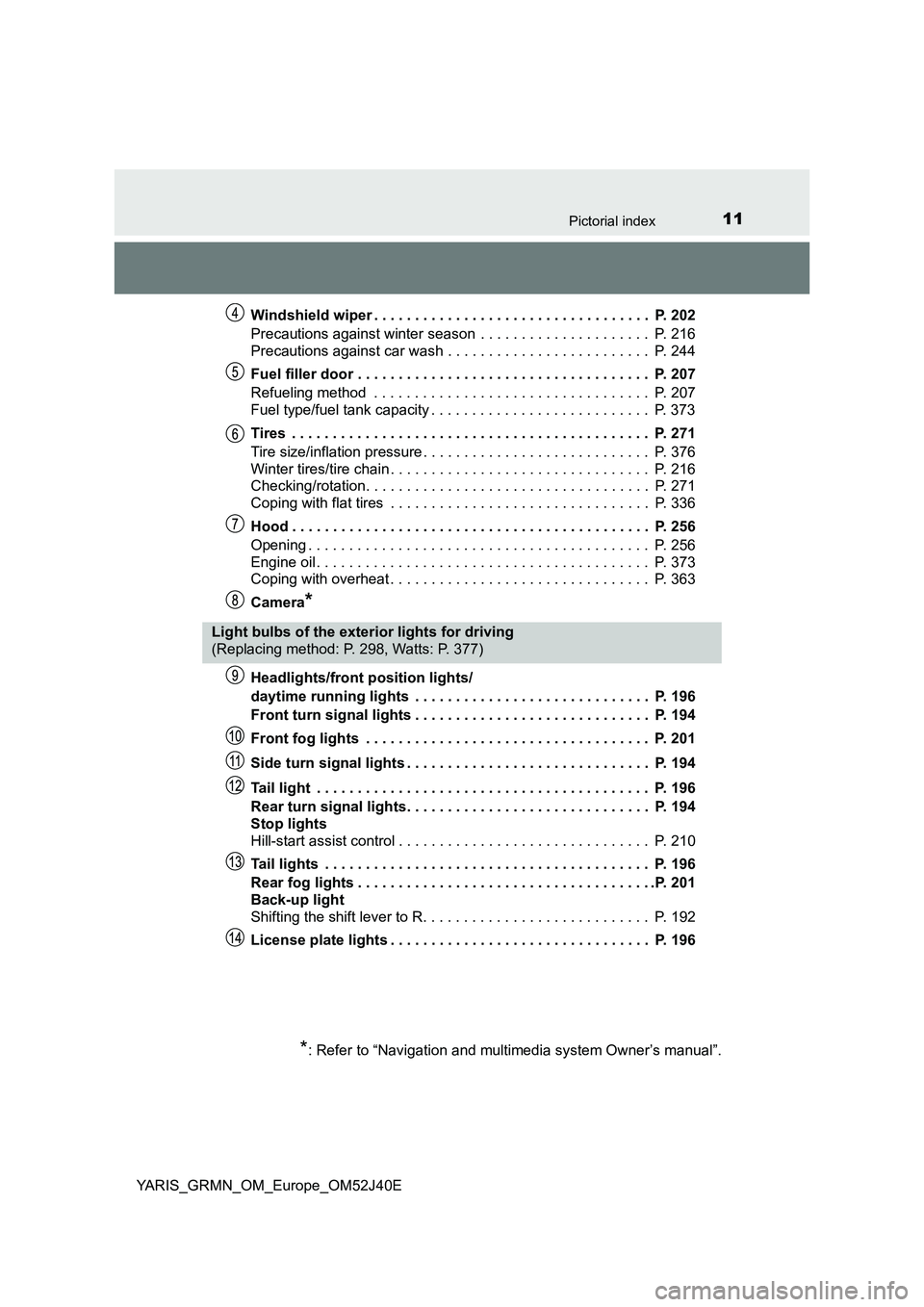
11Pictorial index
YARIS_GRMN_OM_Europe_OM52J40E
Windshield wiper . . . . . . . . . . . . . . . . . . . . . . . . . . . . . . . . . . P. 202
Precautions against winter season . . . . . . . . . . . . . . . . . . . . . P. 216
Precautions against car wash . . . . . . . . . . . . . . . . . . . . . . . . . P. 244
Fuel filler door . . . . . . . . . . . . . . . . . . . . . . . . . . . . . . . . . . . . P. 207
Refueling method . . . . . . . . . . . . . . . . . . . . . . . . . . . . . . . . . . P. 207
Fuel type/fuel tank capacity . . . . . . . . . . . . . . . . . . . . . . . . . . . P. 373
Tires . . . . . . . . . . . . . . . . . . . . . . . . . . . . . . . . . . . . . . . . . . . . P. 271
Tire size/inflation pressure . . . . . . . . . . . . . . . . . . . . . . . . . . . . P. 376
Winter tires/tire chain . . . . . . . . . . . . . . . . . . . . . . . . . . . . . . . . P. 216
Checking/rotation. . . . . . . . . . . . . . . . . . . . . . . . . . . . . . . . . . . P. 271
Coping with flat tires . . . . . . . . . . . . . . . . . . . . . . . . . . . . . . . . P. 336
Hood . . . . . . . . . . . . . . . . . . . . . . . . . . . . . . . . . . . . . . . . . . . . P. 256
Opening . . . . . . . . . . . . . . . . . . . . . . . . . . . . . . . . . . . . . . . . . . P. 256
Engine oil . . . . . . . . . . . . . . . . . . . . . . . . . . . . . . . . . . . . . . . . . P. 373
Coping with overheat . . . . . . . . . . . . . . . . . . . . . . . . . . . . . . . . P. 363
Camera*
Headlights/front position lights/
daytime running lights . . . . . . . . . . . . . . . . . . . . . . . . . . . . . P. 196
Front turn signal lights . . . . . . . . . . . . . . . . . . . . . . . . . . . . . P. 194
Front fog lights . . . . . . . . . . . . . . . . . . . . . . . . . . . . . . . . . . . P. 201
Side turn signal lights . . . . . . . . . . . . . . . . . . . . . . . . . . . . . . P. 194
Tail light . . . . . . . . . . . . . . . . . . . . . . . . . . . . . . . . . . . . . . . . . P. 196
Rear turn signal lights. . . . . . . . . . . . . . . . . . . . . . . . . . . . . . P. 194
Stop lights
Hill-start assist control . . . . . . . . . . . . . . . . . . . . . . . . . . . . . . . P. 210
Tail lights . . . . . . . . . . . . . . . . . . . . . . . . . . . . . . . . . . . . . . . . P. 196
Rear fog lights . . . . . . . . . . . . . . . . . . . . . . . . . . . . . . . . . . . . .P. 201
Back-up light
Shifting the shift lever to R. . . . . . . . . . . . . . . . . . . . . . . . . . . . P. 192
License plate lights . . . . . . . . . . . . . . . . . . . . . . . . . . . . . . . . P. 196
Light bulbs of the exterior lights for driving
(Replacing method: P. 298, Watts: P. 377)
*: Refer to “Navigation and multimedia system Owner’s manual”.
Page 49 of 404
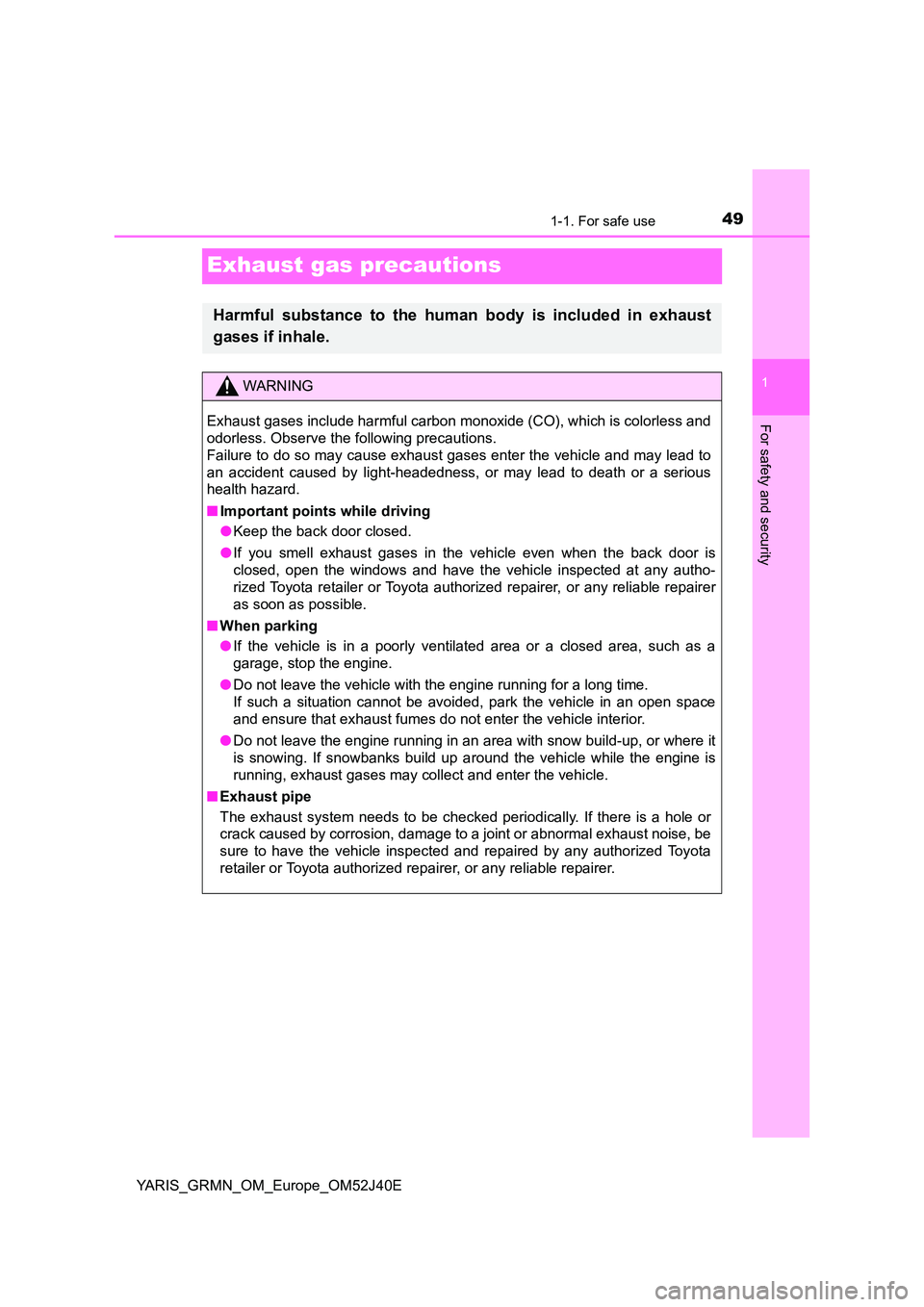
491-1. For safe use
1
For safety and security
YARIS_GRMN_OM_Europe_OM52J40E
Exhaust gas precautions
Harmful substance to the human body is included in exhaust
gases if inhale.
WARNING
Exhaust gases include harmful carbon monoxide (CO), which is colorless and
odorless. Observe the following precautions.
Failure to do so may cause exhaust gases enter the vehicle and may lead to
an accident caused by light-headedness, or may lead to death or a serious
health hazard.
■ Important points while driving
● Keep the back door closed.
● If you smell exhaust gases in the vehicle even when the back door is
closed, open the windows and have the vehicle inspected at any autho-
rized Toyota retailer or Toyota authorized repairer, or any reliable repairer
as soon as possible.
■ When parking
● If the vehicle is in a poorly ventilated area or a closed area, such as a
garage, stop the engine.
● Do not leave the vehicle with the engine running for a long time.
If such a situation cannot be avoided, park the vehicle in an open space
and ensure that exhaust fumes do not enter the vehicle interior.
● Do not leave the engine running in an area with snow build-up, or where it
is snowing. If snowbanks build up around the vehicle while the engine is
running, exhaust gases may collect and enter the vehicle.
■ Exhaust pipe
The exhaust system needs to be checked periodically. If there is a hole or
crack caused by corrosion, damage to a joint or abnormal exhaust noise, be
sure to have the vehicle inspected and repaired by any authorized Toyota
retailer or Toyota authorized repairer, or any reliable repairer.
Page 93 of 404
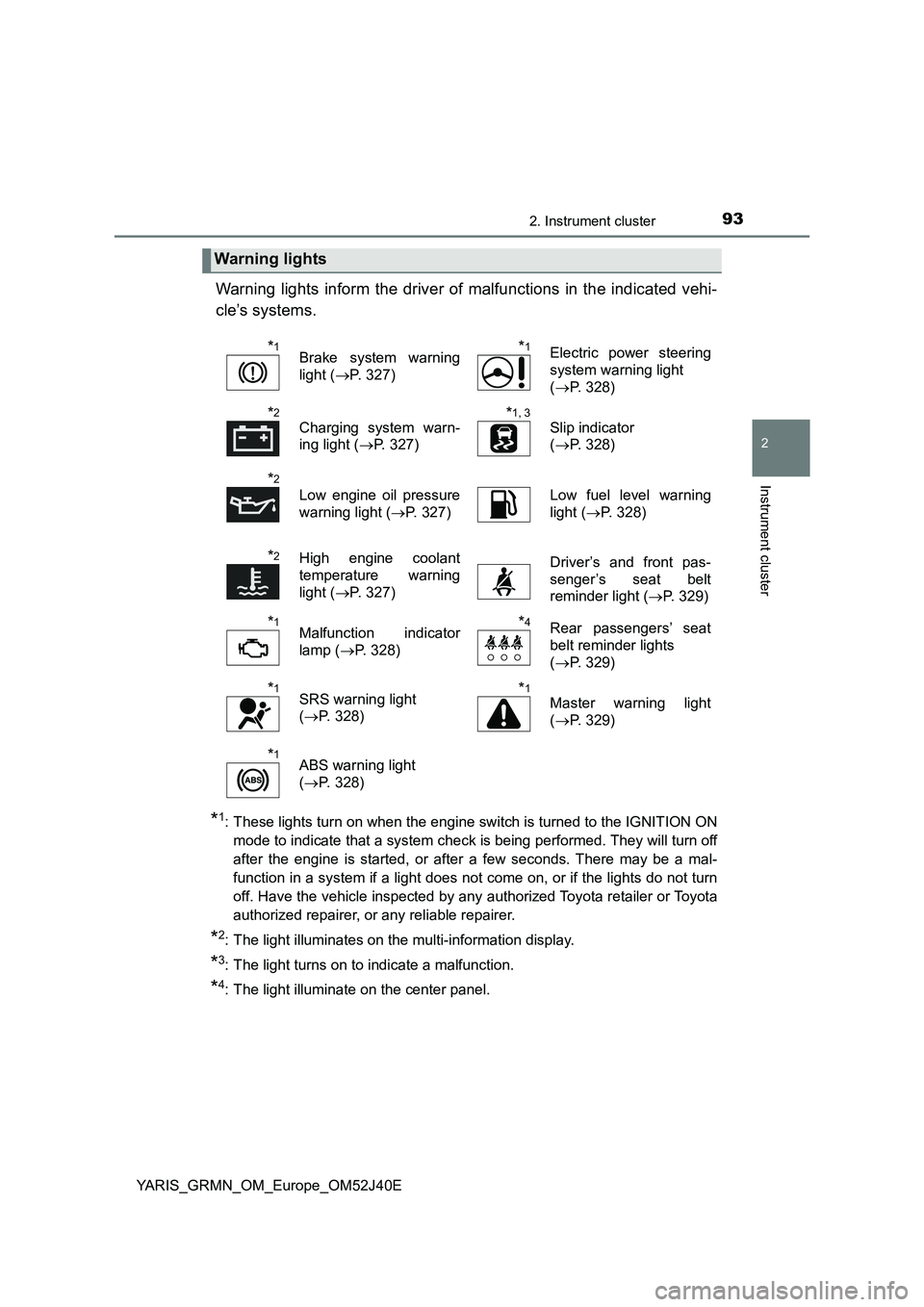
932. Instrument cluster
2
Instrument cluster
YARIS_GRMN_OM_Europe_OM52J40E
Warning lights inform the driver of malfunctions in the indicated vehi-
cle’s systems.
*1: These lights turn on when the engine switch is turned to the IGNITION ON
mode to indicate that a system check is being performed. They will turn off
after the engine is started, or after a few seconds. There may be a mal-
function in a system if a light does not come on, or if the lights do not turn
off. Have the vehicle inspected by any authorized Toyota retailer or Toyota
authorized repairer, or any reliable repairer.
*2: The light illuminates on the multi-information display.
*3: The light turns on to indicate a malfunction.
*4: The light illuminate on the center panel.
Warning lights
*1Brake system warning
light ( P. 327)
*1Electric power steering
system warning light
( P. 328)
*2
Charging system warn-
ing light ( P. 327)
*1, 3
Slip indicator
( P. 328)
*2
Low engine oil pressure
warning light ( P. 327)
Low fuel level warning
light ( P. 328)
*2High engine coolant
temperature warning
light ( P. 327)
Driver’s and front pas-
senger’s seat belt
reminder light ( P. 329)
*1Malfunction indicator
lamp ( P. 328)
*4Rear passengers’ seat
belt reminder lights
( P. 329)
*1SRS warning light
( P. 328)
*1
Master warning light
( P. 329)
*1ABS warning light
( P. 328)
Page 94 of 404
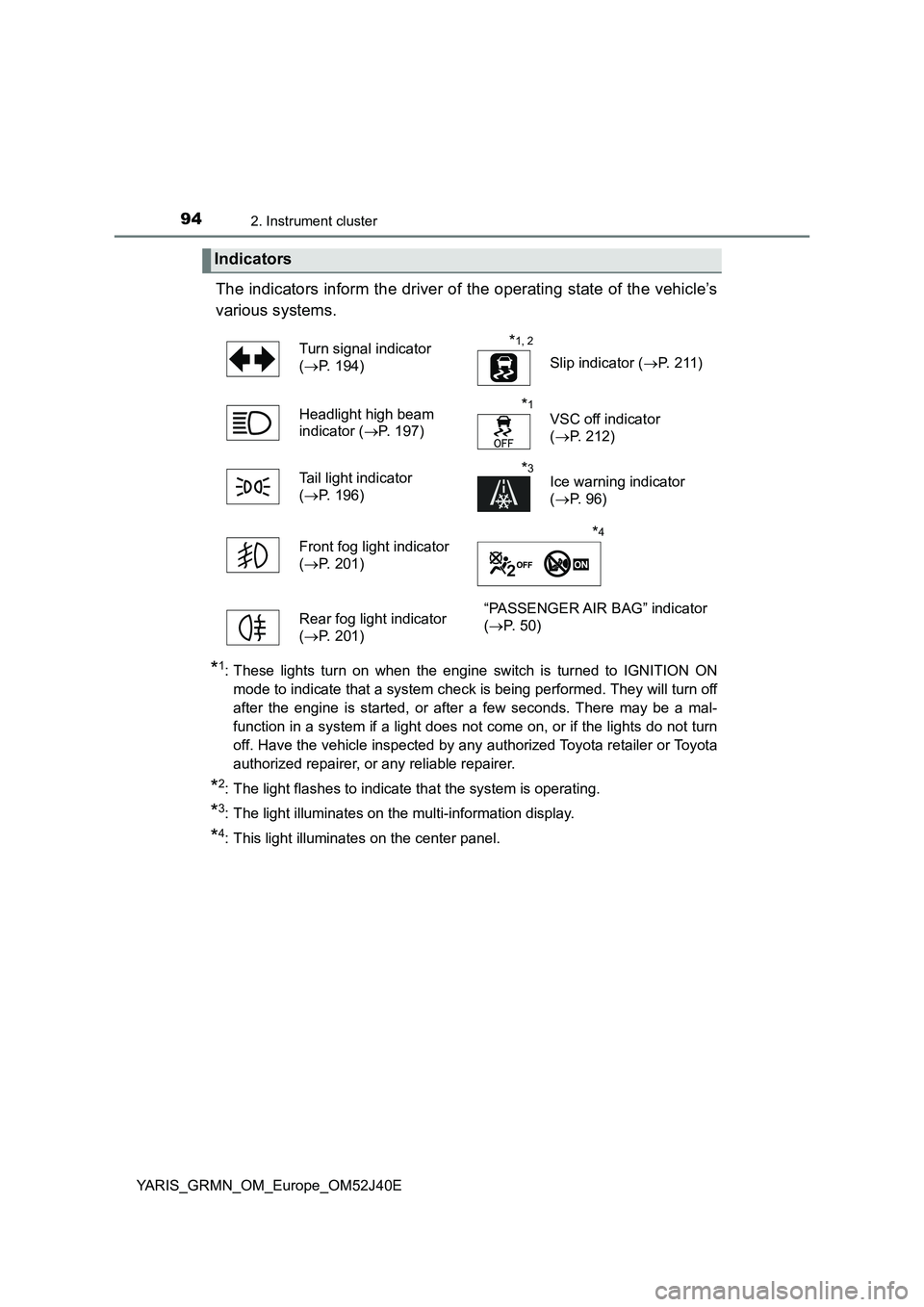
942. Instrument cluster
YARIS_GRMN_OM_Europe_OM52J40E
The indicators inform the driver of the operating state of the vehicle’s
various systems.
*1: These lights turn on when the engine switch is turned to IGNITION ON
mode to indicate that a system check is being performed. They will turn off
after the engine is started, or after a few seconds. There may be a mal-
function in a system if a light does not come on, or if the lights do not turn
off. Have the vehicle inspected by any authorized Toyota retailer or Toyota
authorized repairer, or any reliable repairer.
*2: The light flashes to indicate that the system is operating.
*3: The light illuminates on the multi-information display.
*4: This light illuminates on the center panel.
Indicators
Turn signal indicator
( P. 194)
*1, 2
Slip indicator (P. 2 11 )
Headlight high beam
indicator ( P. 197)
*1
VSC off indicator
( P. 212)
Tail light indicator
( P. 196)
*3Ice warning indicator
( P. 96)
Front fog light indicator
( P. 201)
*4
Rear fog light indicator
( P. 201)
“PASSENGER AIR BAG” indicator
( P. 5 0 )
Page 178 of 404
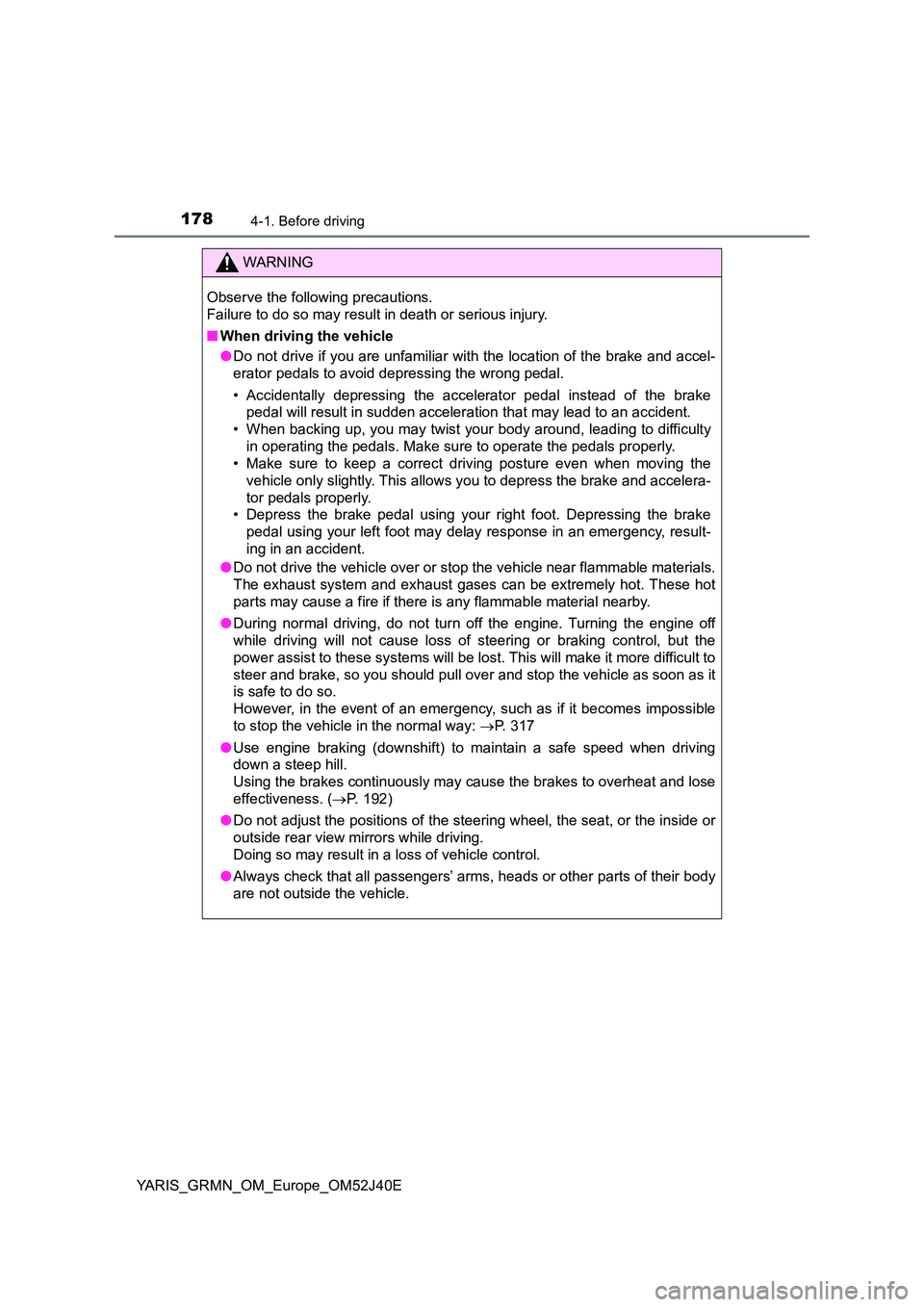
1784-1. Before driving
YARIS_GRMN_OM_Europe_OM52J40E
WARNING
Observe the following precautions.
Failure to do so may result in death or serious injury.
■ When driving the vehicle
● Do not drive if you are unfamiliar with the location of the brake and accel-
erator pedals to avoid depressing the wrong pedal.
• Accidentally depressing the accelerator pedal instead of the brake
pedal will result in sudden acceleration that may lead to an accident.
• When backing up, you may twist your body around, leading to difficulty
in operating the pedals. Make su re to operate the pedals properly.
• Make sure to keep a correct driving posture even when moving the
vehicle only slightly. This allows you to depress the brake and accelera-
tor pedals properly.
• Depress the brake pedal using your right foot. Depressing the brake
pedal using your left foot may delay response in an emergency, result-
ing in an accident.
● Do not drive the vehicle over or stop the vehicle near flammable materials.
The exhaust system and exhaust gases can be extremely hot. These hot
parts may cause a fire if there is any flammable material nearby.
● During normal driving, do not turn off the engine. Turning the engine off
while driving will not cause loss of steering or braking control, but the
power assist to these systems will be lost. This will make it more difficult to
steer and brake, so you should pull over and stop the vehicle as soon as it
is safe to do so.
However, in the event of an emergency, such as if it becomes impossible
to stop the vehicle in the normal way: P. 317
● Use engine braking (downshift) to maintain a safe speed when driving
down a steep hill.
Using the brakes continuously may cause the brakes to overheat and lose
effectiveness. ( P. 1 9 2 )
● Do not adjust the positions of the steering wheel, the seat, or the inside or
outside rear view mirrors while driving.
Doing so may result in a loss of vehicle control.
● Always check that all passengers’ arms, heads or other parts of their body
are not outside the vehicle.
Page 180 of 404
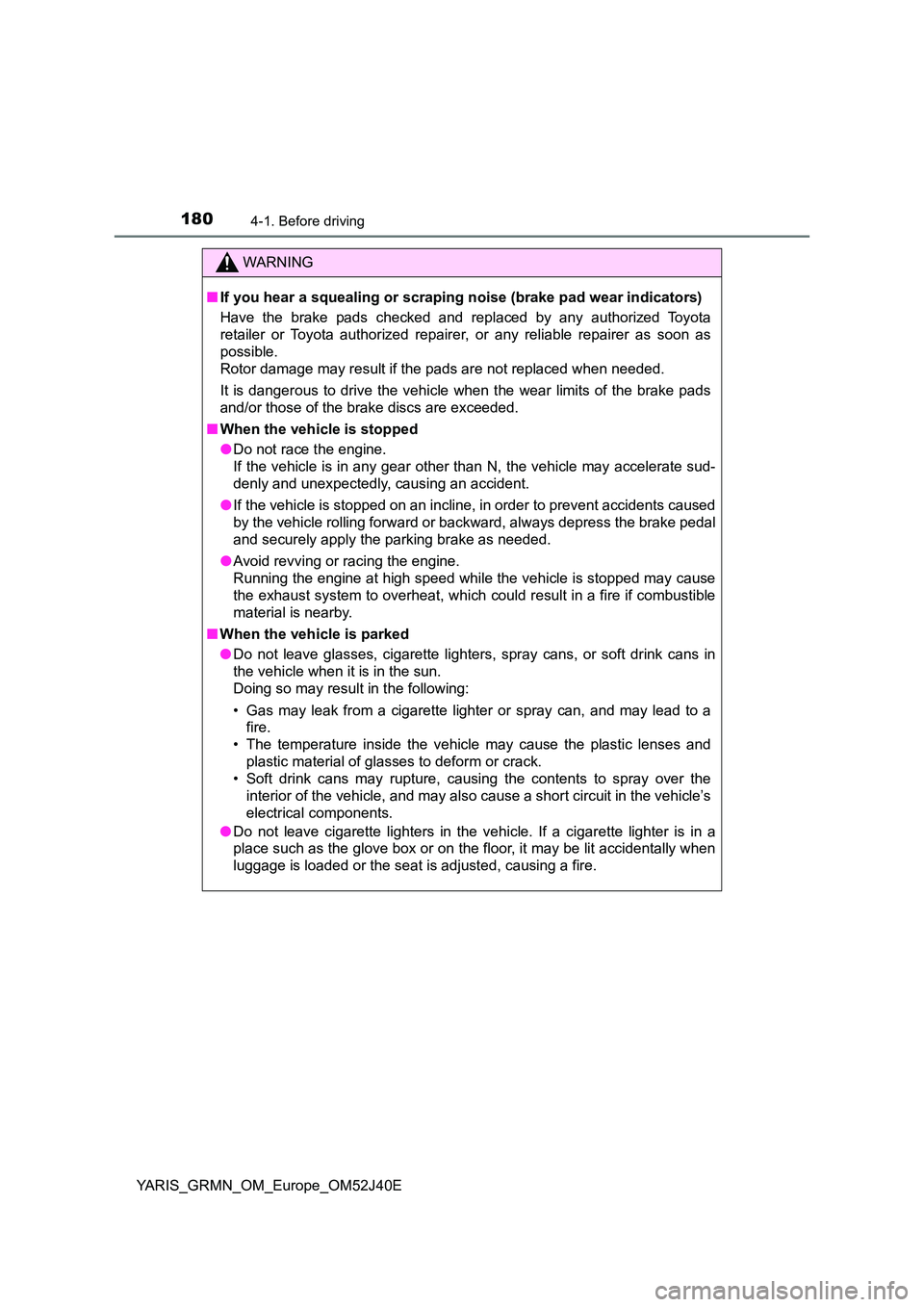
1804-1. Before driving
YARIS_GRMN_OM_Europe_OM52J40E
WARNING
■If you hear a squealing or scraping noise (brake pad wear indicators)
Have the brake pads checked and replaced by any authorized Toyota
retailer or Toyota authorized repairer, or any reliable repairer as soon as
possible.
Rotor damage may result if the pads are not replaced when needed.
It is dangerous to drive the vehicle w hen the wear limits of the brake pads
and/or those of the brake discs are exceeded.
■ When the vehicle is stopped
● Do not race the engine.
If the vehicle is in any gear other than N, the vehicle may accelerate sud-
denly and unexpectedly, causing an accident.
● If the vehicle is stopped on an incline, in order to prevent accidents caused
by the vehicle rolling forward or backward, always depress the brake pedal
and securely apply the parking brake as needed.
● Avoid revving or racing the engine.
Running the engine at high speed while the vehicle is stopped may cause
the exhaust system to overheat, which could result in a fire if combustible
material is nearby.
■ When the vehicle is parked
● Do not leave glasses, cigarette lighters, spray cans, or soft drink cans in
the vehicle when it is in the sun.
Doing so may result in the following:
• Gas may leak from a cigarette lighter or spray can, and may lead to a
fire.
• The temperature inside the vehicle may cause the plastic lenses and
plastic material of glasses to deform or crack.
• Soft drink cans may rupture, causing the contents to spray over the
interior of the vehicle, and may also cause a short circuit in the vehicle’s
electrical components.
● Do not leave cigarette lighters in the vehicle. If a cigarette lighter is in a
place such as the glove box or on the floor, it may be lit accidentally when
luggage is loaded or the seat is adjusted, causing a fire.
Page 191 of 404
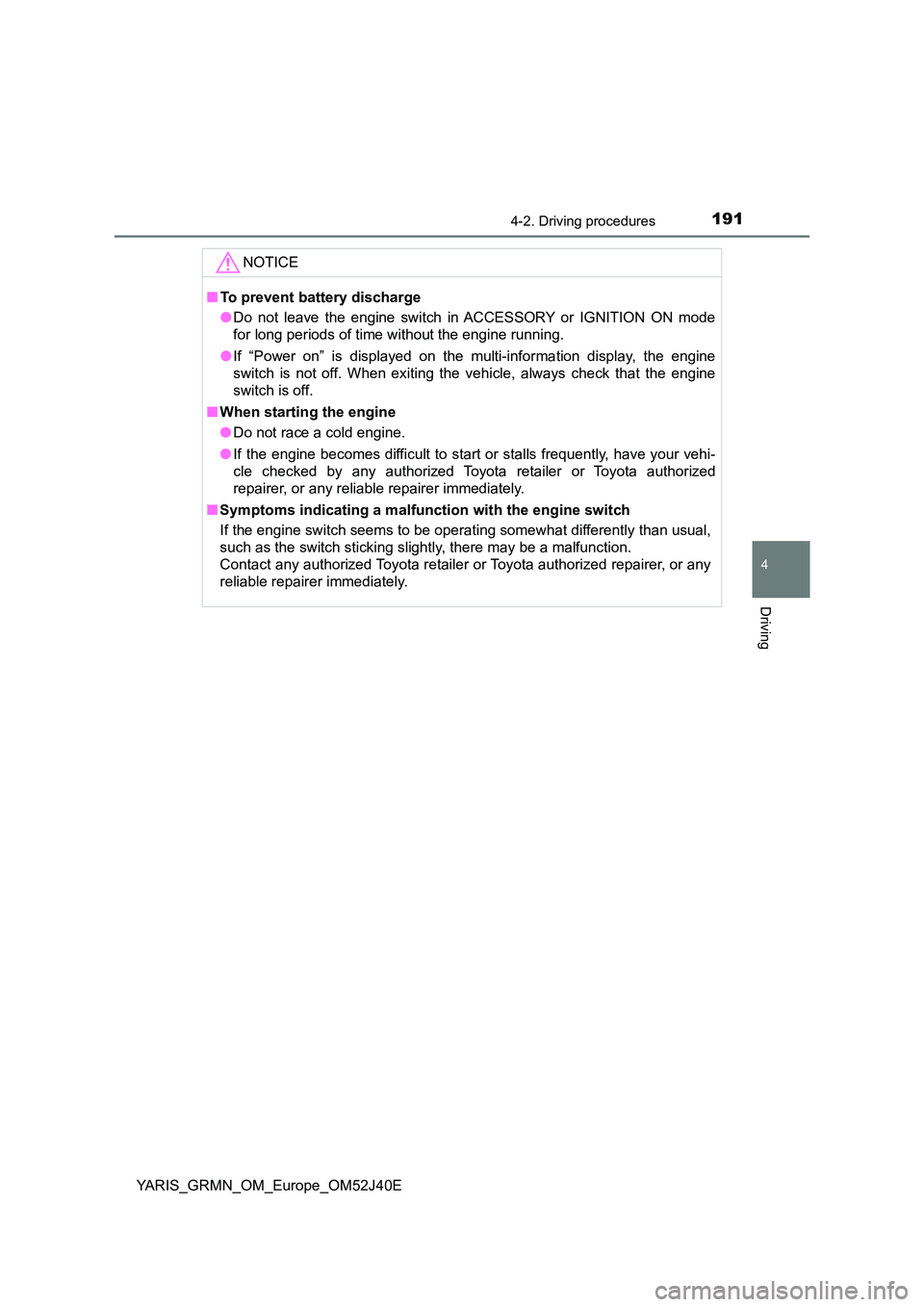
1914-2. Driving procedures
4
Driving
YARIS_GRMN_OM_Europe_OM52J40E
NOTICE
■To prevent battery discharge
● Do not leave the engine switch in ACCESSORY or IGNITION ON mode
for long periods of time without the engine running.
● If “Power on” is displayed on the multi-information display, the engine
switch is not off. When exiting the vehicle, always check that the engine
switch is off.
■ When starting the engine
● Do not race a cold engine.
● If the engine becomes difficult to start or stalls frequently, have your vehi-
cle checked by any authorized Toyota retailer or Toyota authorized
repairer, or any reliable repairer immediately.
■ Symptoms indicating a malfunction with the engine switch
If the engine switch seems to be operating somewhat differently than usual,
such as the switch sticking slightly, there may be a malfunction.
Contact any authorized Toyota retailer or Toyota authorized repairer, or any
reliable repairer immediately.
Page 194 of 404
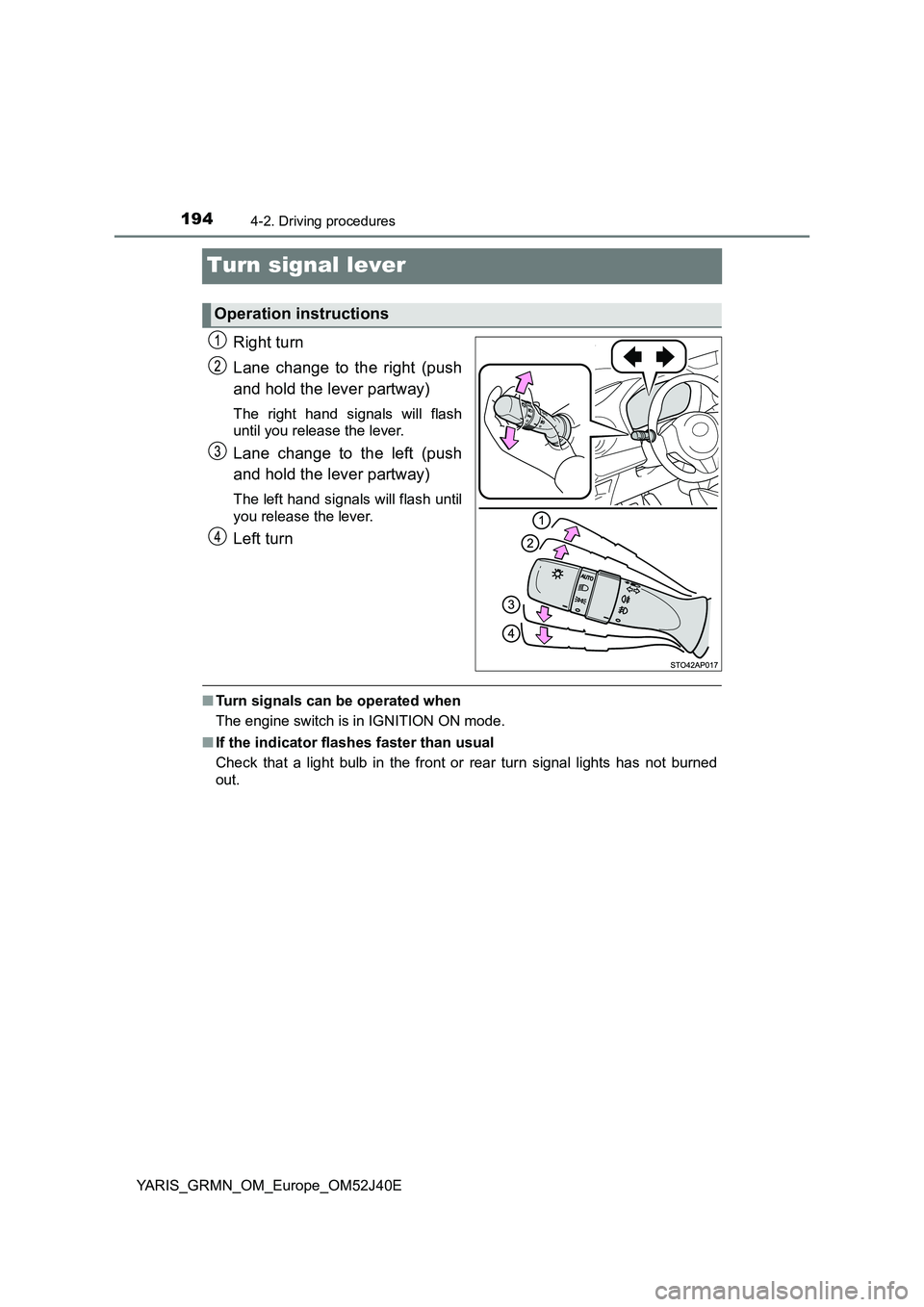
1944-2. Driving procedures
YARIS_GRMN_OM_Europe_OM52J40E
Turn signal lever
Right turn
Lane change to the right (push
and hold the lever partway)
The right hand signals will flash
until you release the lever.
Lane change to the left (push
and hold the lever partway)
The left hand signals will flash until
you release the lever.
Left turn
■ Turn signals can be operated when
The engine switch is in IGNITION ON mode.
■ If the indicator flashes faster than usual
Check that a light bulb in the front or rear turn signal lights has not burned
out.
Operation instructions
Page 203 of 404
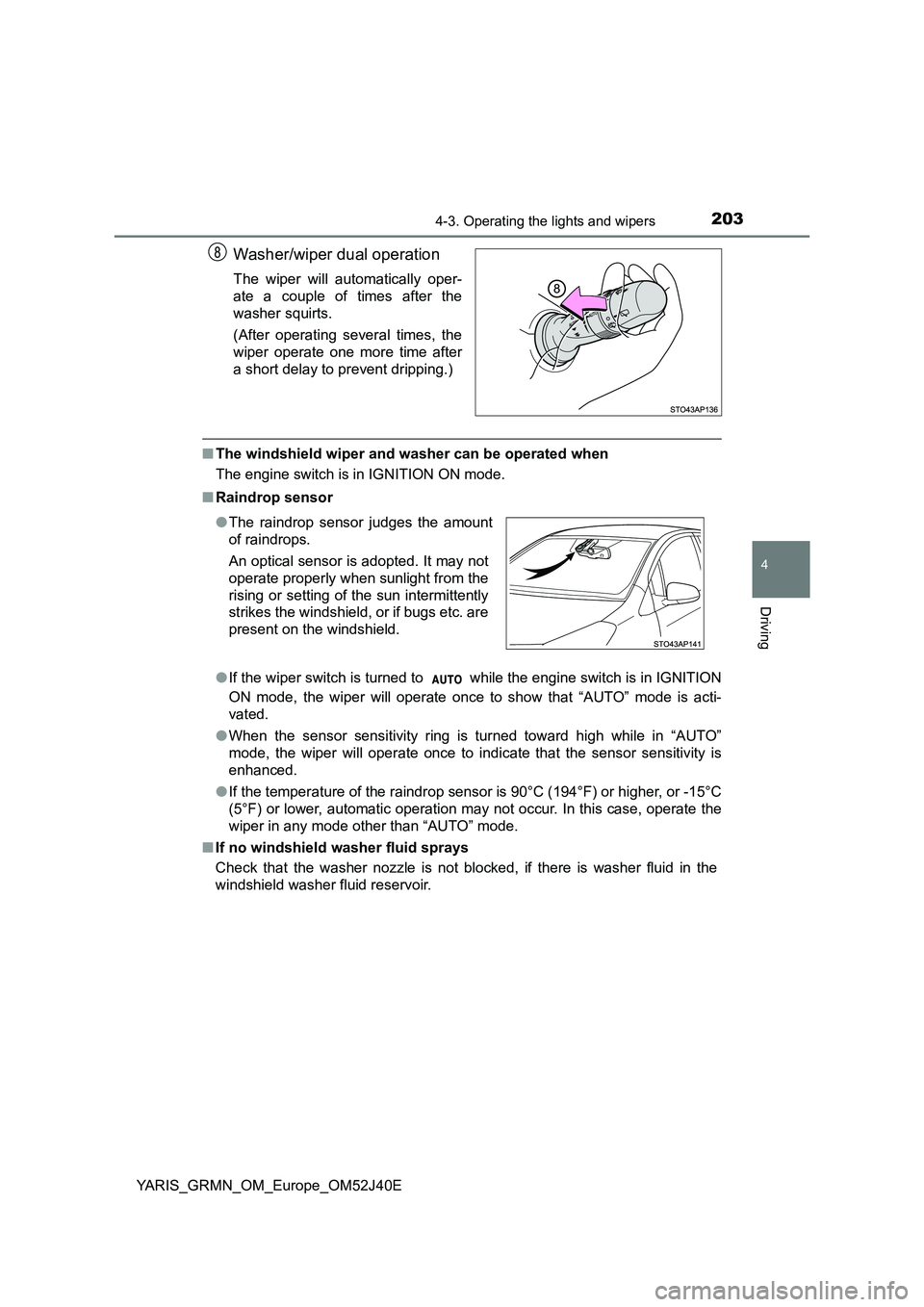
2034-3. Operating the lights and wipers
4
Driving
YARIS_GRMN_OM_Europe_OM52J40E
Washer/wiper dual operation
The wiper will automatically oper-
ate a couple of times after the
washer squirts.
(After operating several times, the
wiper operate one more time after
a short delay to prevent dripping.)
■ The windshield wiper and washer can be operated when
The engine switch is in IGNITION ON mode.
■ Raindrop sensor
● If the wiper switch is turned to while the engine switch is in IGNITION
ON mode, the wiper will operate once to show that “AUTO” mode is acti-
vated.
● When the sensor sensitivity ring is turned toward high while in “AUTO”
mode, the wiper will operate once to indicate that the sensor sensitivity is
enhanced.
● If the temperature of the raindrop sensor is 90°C (194°F) or higher, or -15°C
(5°F) or lower, automatic operation may not occur. In this case, operate the
wiper in any mode other than “AUTO” mode.
■ If no windshield washer fluid sprays
Check that the washer nozzle is not blocked, if there is washer fluid in the
windshield washer fluid reservoir.
● The raindrop sensor judges the amount
of raindrops.
An optical sensor is adopted. It may not
operate properly when sunlight from the
rising or setting of the sun intermittently
strikes the windshield, or if bugs etc. are
present on the windshield.